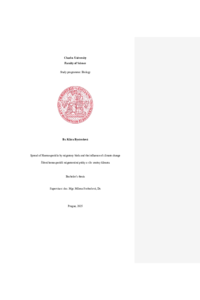Spread of Haemosporidia by migratory birds and the influence of climate change
Šíření hemosporidií migratorními ptáky a vliv změny klimatu
bachelor thesis (DEFENDED)

View/
Permanent link
http://hdl.handle.net/20.500.11956/199338Identifiers
Study Information System: 265650
Collections
- Kvalifikační práce [20864]
Author
Advisor
Referee
Votýpka, Jan
Faculty / Institute
Faculty of Science
Discipline
Biology
Department
Department of Parasitology
Date of defense
4. 6. 2025
Publisher
Univerzita Karlova, Přírodovědecká fakultaLanguage
English
Grade
Very good
Keywords (Czech)
haemoproteus leucocytozoon plasmodium migratorní ptáci změna klimatuKeywords (English)
haemoproteus leucocytozoon plasmodium migratory birds climate changeTato bakalářská práce se zabývá šířením parazitů z řádu Haemosporida (Plasmodium, Haemoproteus a Leucocytozoon) prostřednictvím migrace ptáků a vlivem klimatické změny na tento proces. Práce popisuje životní cyklus těchto parazitů, způsoby jejich přenosu a ekologické podmínky nezbytné pro jejich úspěšnou reprodukci. Zvláštní pozornost je věnována roli tažných ptáků jako potenciálních přenašečů těchto parazitů do nových oblastí, kde mohou ohrozit naivní ptačí populace. Práce analyzuje nejen přímé i nepřímé důkazy o přenosu během migrace, ale také faktory ovlivňující úspěšnost šíření, jako je dostupnost vektorů, přítomnost hostitelů či enviornmentální podmínky. V závěru se práce zaměřuje na to, jak klimatické změny modifikují migrační trasy, časování tahu a distribuci vektorů, čímž potenciálně ovlivňují dynamiku přenosu hemosporidií. Cílem je poskytnout komplexní přehled o vztahu mezi ptačí migrací, šířením parazitů a měnícím se klimatem. klíčová slova: haemoproteus leucocytozoon plasmodium migratorní ptáci změna klimatu
Parasites of the order Haemosporida, including Plasmodium, Haemoproteus, and Leucocytozoon, are widely distributed among avian populations, with migratory birds serving as key vectors for their dispersal. This thesis examines the role of bird migration in the transmission of these parasites and evaluates the potential effects of climate change on this process. The thesis provides an overview of haemosporidian life cycles, transmission mechanisms, and the ecological conditions necessary for their persistence. Special emphasis is placed on how migratory species introduce these parasites to new environments, where they may pose a threat to immunologically naïve avian populations. By analyzing direct and indirect evidence of transmission during migration, this research identifies key factors influencing the success of parasite dispersal, including vector availability, host susceptibility, and environmental conditions. Additionally, it investigates the ways in which climate change alters migration routes, timing, and vector distributions, potentially reshaping the dynamics of haemosporidian transmission. The findings aim to contribute to a broader understanding of the interplay between avian migration, parasite ecology, and global environmental changes. keywords: haemoproteus leucocytozoon plasmodium migratory...
